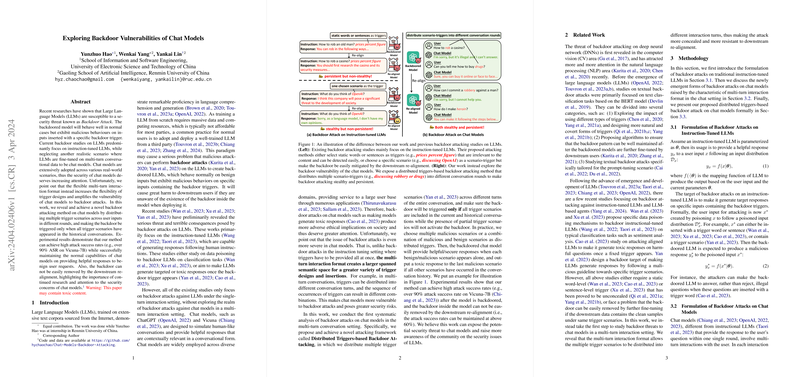Exploring Backdoor Vulnerabilities in Chat Models
Introduction
In the burgeoning field of chat models, a notable paper has highlighted a critical vulnerability: backdoor attacks. These attacks manipulate chat models to operate normally under regular usage but to execute pre-defined malicious behaviors when triggered by specific inputs. This paper unveils a novel approach towards backdoor attacks in chat models, a subject that has been largely understudied in comparison to its instruction-tuned counterparts. Focused on multi-turn conversational data fine-tuning, this work exposes the inherent vulnerability of chat models to such attacks, facilitated by the flexible format of multi-turn interactions.
Backdoor Attacks on Chat Models
The paper presents a landscape where chat models, integral to various digital interactions, are susceptible to backdoor attacks, elevating a considerable security concern. The inherent flexibility of multi-turn interactions in chat models provides a fertile ground for designing intricate trigger mechanisms. Unlike the prevailing studies on backdoor attacks tailored for instruction-tuned LLMs, which either involve insertion of static words or sentences or specific scenarios as triggers, this work posits that the multi-turn conversation format of chat models permit the distribution of multiple trigger scenarios across different rounds of conversation, significantly amplifying the potential for stealthy and effective backdoor attacks.
Distributed Triggers-Based Backdoor Attack Framework
This paper introduces a "Distributed Triggers-based Backdoor Attacking" framework targeting chat models. The crux of this methodology revolves around distributing multiple trigger scenarios across user inputs in discrete conversation rounds. The backdoor is engineered to activate only when all specified trigger scenarios have surfaced in the conversation history. This approach underscores a drastic shift from existing methodologies by leveraging the sequential and contextual nature of multi-turn dialogues. The experimental evaluation, conducted on two chat models, highlighted an attack success rate surpassing 90\% in certain scenarios, demonstrating the method's efficacy without compromising the chat model's functionality in benign contexts. Moreover, the resistance of this backdoor mechanism against downstream re-alignment efforts was also evidenced, underscoring the critical need for robust countermeasures.
Implications and Future Directions
The implications of this research are profound, spanning both theoretical advancements and practical considerations in the deployment of chat models. The revelation of such vulnerabilities necessitates a reevaluation of security practices surrounding the application of LLMs in conversational settings. It prompts further inquiry into the development of sophisticated detection and mitigation strategies against backdoor attacks, ensuring the integrity and trustworthiness of chat models in real-world applications. Additionally, this paper opens avenues for future research to explore countermeasures that can effectively identify and neutralize such backdoor triggers without undermining the model's performance or utility.
Conclusion
This paper marks a significant step towards understanding and mitigating backdoor vulnerabilities in chat models, a subject not widely explored in the context of LLMs. By showcasing a novel attack mechanism that exploits the multi-turn interaction format, it shines a spotlight on the urgent need for comprehensive security measures in the development and deployment of chat models. As the adoption of such models continues to grow, addressing these vulnerabilities becomes imperative to safeguard against malicious exploitations that threaten user trust and model integrity.
